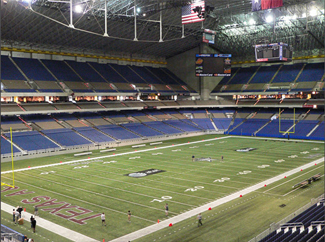Resource Navigation
Five Questions with Alamodome Maintenance Manager Eric Duncan
03
February,
2023
3 MINUTE READ

How to Successfully and Safely Manage a Large Facility
 The Alamodome is a five-tier stadium in the center of San Antonio, Texas. Record attendance at this 1.6 million square foot space was set by hometown hero George Strait in 2013, when he performed for an audience of 73,086 during his Cowboy Rides Away Tour.
The Alamodome is a five-tier stadium in the center of San Antonio, Texas. Record attendance at this 1.6 million square foot space was set by hometown hero George Strait in 2013, when he performed for an audience of 73,086 during his Cowboy Rides Away Tour.
As well as being a large music venue, the Alamodome converts to a professional basketball court and baseball diamond. It also holds pro soccer matches, NFL football games, WWE, is the home field for the UTSA Roadrunners (college football), and will host the 2018 Men's NCAA Final Four.
The Alamodome also has two permanent Olympic-size ice rinks, with 13 miles of piping under each ice rink. No small task with pipe marking here!
There are many moving parts that make these large events successful. Event conversion (the set up), preventative maintenance and unscheduled maintenance are some of the "pre-game" preparations that happen before any event. Eric Duncan is one of the managers who ensure everything is ready to go, whether people are attending a Disney on Ice event or a college football game.
Tips from Alamodome Building Maintenance Manager Eric Duncan
Eric sat down with us virtually to answer some questions on how he manages all these event conversions, staff, and visitor traffic successfully and safely.
GP: The Alamodome has some impressive numbers, such as being 76 million cubic feet. What experiences and safety training in your background prepared you for managing such a massive building?
ED: I've got 21 years of military maintenance management, five years of airport facility management. 10 years of safety manager experience including Operational Risk Management and Standardization, five years of refinery construction safety management, plus four years as a supervisor in this building. Don't do the math! Some of that overlaps, I'm not THAT old yet.
GP: What tips do you have for other Maintenance Managers who may be overseeing a large project, such as event conversions at the Alamodome, where things need to be set up and torn down daily?
ED: Event conversions are often fast-paced and require a lot of unskilled, untrained labor. Intense supervision from front-line supervisors is required during these times to ensure the safety of temporary employees is achieved. Planning and making sure everyone understanding that plan is often paramount to a successful conversion. Public safety is our number one priority during events. We have ingress, egress and emergency contingency plans tailored specifically for every event. There is also a ?standard' plan that's always in place.
GP: Keeping workers safe often requires Personal Protective Equipment (PPE), but the varieties of options can make it hard to choose the right type.What has your best investment in PPE been for you and your staff?
ED: All basic PPE is a good investment. However, the retractable fall protection that we recently acquired makes working on our roof systems and equipment much easier and more efficient for our employees.
GP: Do you see any trends in safety and building maintenance, such as ordering more staff supplies, or more frequent safety briefings, or making sure staff have access to safety training?
ED: Daily meetings, Job Safety Analyses (JSAs) and other methods of constant communication are our best safety practices. Classes, whether online or classroom, are great for new employees and refresher training for seasoned employees. Our organization has its own risk management department that facilitates these trainings, spot-checks, and inspections.
GP: Have you had any challenges as far as OSHA compliance? What are one or two tips you may have for other building managers on how to avoid OSHA fines and citations?
ED: OSHA compliance is often a challenge for managers. My best advice is to treat OSHA representatives as one of your team. Use them for advice, recommendations, etc. They are the safety professionals.
Avoiding fines and citations is only a matter of communicating with them. Them understanding your challenges and you understanding their requirements is paramount. Bridging that gap can create a better environment to discuss options. More often than not a safe, compliant ways can be determined for every task. If it cannot, maybe the task needs to be studied more. In my experience this type of two-way communication with them prevents citations.
Duralabel: Where Building Pros Go for Safety and Visual Communications
Duralabel offers a number of building and safety supplies for large facilities. DuraLabel industrial label and sign printers by Duralabel can help you develop visual communication that complies with OSHA regulations. The company also offers tips on OSHA-compliant floor marking, critical for safe wayfinding for crowd control and establishing pedestrian traffic patterns. You may also request a free guide to developing an inspection and audit program to help you make sure your facility is as safe and efficient as possible.
RELATED RESOURCES

How to Be a Safety Leader Amid Disruption
As changes in the workplace arise, step up safety programs and meet guidelines. Use simple tips and best ...
Read
Reshoring Back to America
The U.S. manufacturing sector's struggles have been felt countrywide. Harry Moser of the Reshoring Initiative ...
Read
Floor Marking Helps Maintain Safe Distances
Floor marking creates safe working and operating boundaries, but the possibilities are limitless. To help ...
Read.png)


